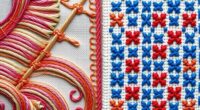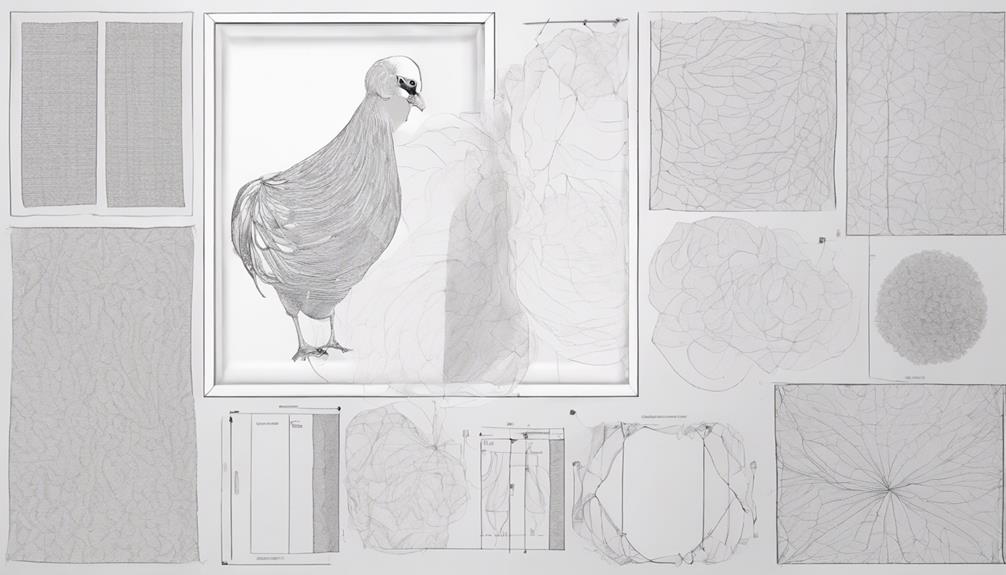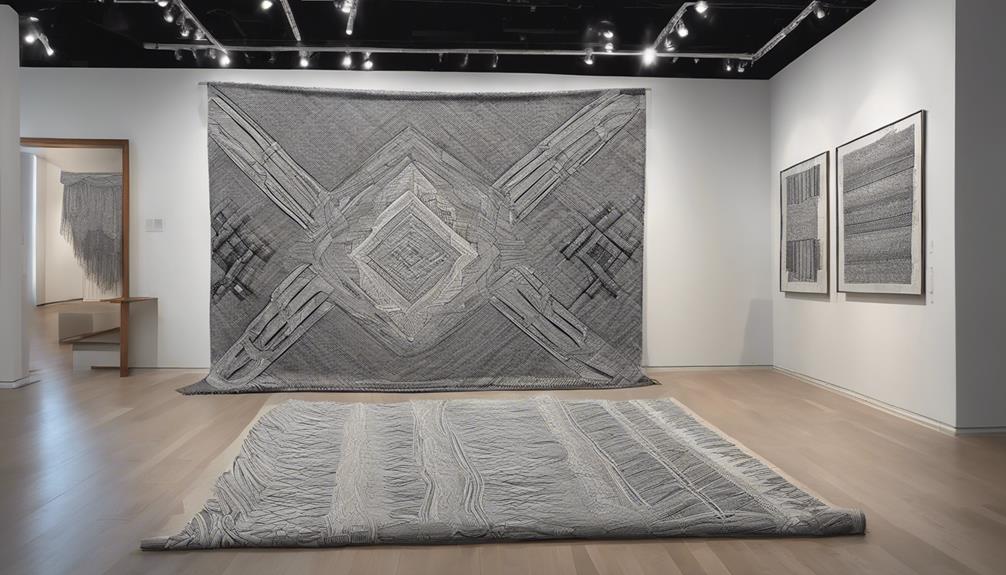To turn fabric into a canvas, start by thoroughly washing and drying it to remove chemicals and improve paint adhesion. Use fabric-specific acrylics or textile paints, testing them on scrap first. Prepare your design with pencils or chalk, then layer colors carefully using brushes suited for details or broad coverage. Incorporate dyeing techniques like gradients or tie-dye for vibrant backgrounds. Finish by properly setting the paint to guarantee durability, and if you keep exploring, you’ll discover even more creative possibilities.
Key Takeaways
- Properly wash and dry fabric to remove chemicals, ensuring better paint adhesion and durability.
- Use fabric-specific acrylics or textile paints, testing on scrap fabric before starting your project.
- Sketch designs lightly with pencil or fabric chalk to maintain precision during painting.
- Apply paint in layers, starting with thin coats to prevent bleeding and achieve vibrant colors.
- Follow manufacturer instructions to set the paint with heat or curing, ensuring the artwork is washable and long-lasting.

Have you ever wanted to transform plain fabric into a work of art? If so, painting on fabric offers a fantastic way to turn simple cloth into a vibrant canvas. This process isn’t just about applying paint; it’s an art form that combines creativity with techniques like fabric dyeing and textile design to produce unique, personalized pieces. Whether you’re creating a custom shirt, a decorative wall hanging, or a one-of-a-kind tote bag, understanding how to paint on fabric helps you craft something truly special.
Transform plain fabric into vibrant, personalized art with creative painting, dyeing, and textile techniques.
When you begin, it’s important to prepare your fabric properly. Wash and dry it thoroughly to remove any sizing or chemicals that might interfere with the paint’s adhesion. Once clean, you can think about fabric dyeing as your first step in textile design. Fabric dyeing allows you to create a colorful background or base for your artwork, giving your piece depth and richness. You can use dyes to add gradients, tie-dye effects, or subtle color variations that will make your painted design pop. Think of fabric dyeing as the foundation of your textile design, setting the mood and tone for your final piece.
Next, choose the right paint for fabric. Fabric-specific acrylics or textile paints are specially formulated to adhere to cloth without cracking or fading over time. Before you start painting, test your paints on a scrap piece of fabric to see how they behave and to practice your techniques. When you’re ready, sketch your design lightly with a pencil or fabric chalk. This helps keep your work precise, especially if you’re planning intricate details or lettering.
As you paint, use brushes suitable for the detail or coverage you desire. Thin brushes work well for fine lines and small details, while larger brushes are perfect for filling in bigger areas. Remember, layering is key—build up your colors gradually to avoid bleeding or muddying your design. If you want to add texture or special effects, consider using fabric markers, stencils, or even fabric mediums that can create different finishes. Additionally, understanding fabric preparation techniques can significantly improve the durability and appearance of your artwork.
Finally, once your design is complete, set the paint by following the manufacturer’s instructions—usually involving heat setting with an iron or letting it cure for a specific period. This step ensures your artwork stays vibrant and durable through washing and wear. With practice, your skill in fabric dyeing and textile design will grow, allowing you to experiment with different styles, techniques, and textures. Painting on fabric isn’t just a craft; it’s a way to express your creativity and create wearable or decorative art that’s uniquely yours.
Frequently Asked Questions
What Types of Fabric Are Best for Painting?
You should choose fabrics with a smooth texture and good paint absorption for the best results. Cotton and linen are ideal because their tight weave allows paint to adhere well without bleeding, giving you vibrant colors and sharp details. Avoid fabrics like silk or polyester, which have slick textures and poor absorption, making it harder for your paint to stick evenly. Opt for natural fibers for a smoother, more professional finish.
How Do I Prevent Paint From Cracking on Fabric?
To prevent paint from cracking on fabric, you should focus on proper fabric preparation and ensuring good paint adhesion. First, wash and iron your fabric to remove any residues and create a smooth surface. Use a fabric medium mixed with your paint for better flexibility and adhesion. Apply thin, even layers, allowing each to dry thoroughly. This helps maintain the fabric’s natural stretch and prevents cracking over time.
Can I Wash Painted Fabric Without Damaging the Artwork?
Yes, you can wash painted fabric without damaging your artwork if you follow proper care. Use gentle fabric dyeing techniques and avoid harsh detergents. Turn the fabric inside out, and hand wash or select a delicate cycle on your machine. Make sure to use textile painting tools that are washable and dry cleanable. Air dry your fabric to preserve the colors and prevent cracking or fading over time.
What Are the Fastest Drying Paints for Fabric?
Did you know that acrylic paints can dry in as little as 10-20 minutes? For fabric dyeing and textile printing, fast-drying paints like acrylics and fabric markers are your best bet. They let you work quickly and layer colors without long waits. Just make certain you use fabric medium to keep the paint flexible. This way, your artwork stays vibrant and durable, even after drying in record time.
How Do I Fix Mistakes on Painted Fabric?
If you make a mistake on painted fabric, start by gently blotting with a damp cloth to remove excess paint. Use fabric dye techniques like reapplying color or blending to fix or hide errors. Before painting, guarantee proper textile surface preparation, such as washing and ironing the fabric. For stubborn mistakes, consider using a fabric medium or dye remover, but always test first to avoid damaging your cloth.
Conclusion
Now, as you bring your fabric to life with paint, remember that it’s both a delicate canvas and a bold statement. Just like the fabric’s soft texture contrasts with the vivid colors you apply, your creativity balances precision with spontaneity. Embrace how the gentle fabric holds your vision, yet transforms into a vibrant masterpiece. In this dance between cloth and color, you’ll discover that turning fabric into art is both a tender process and a daring expression.










